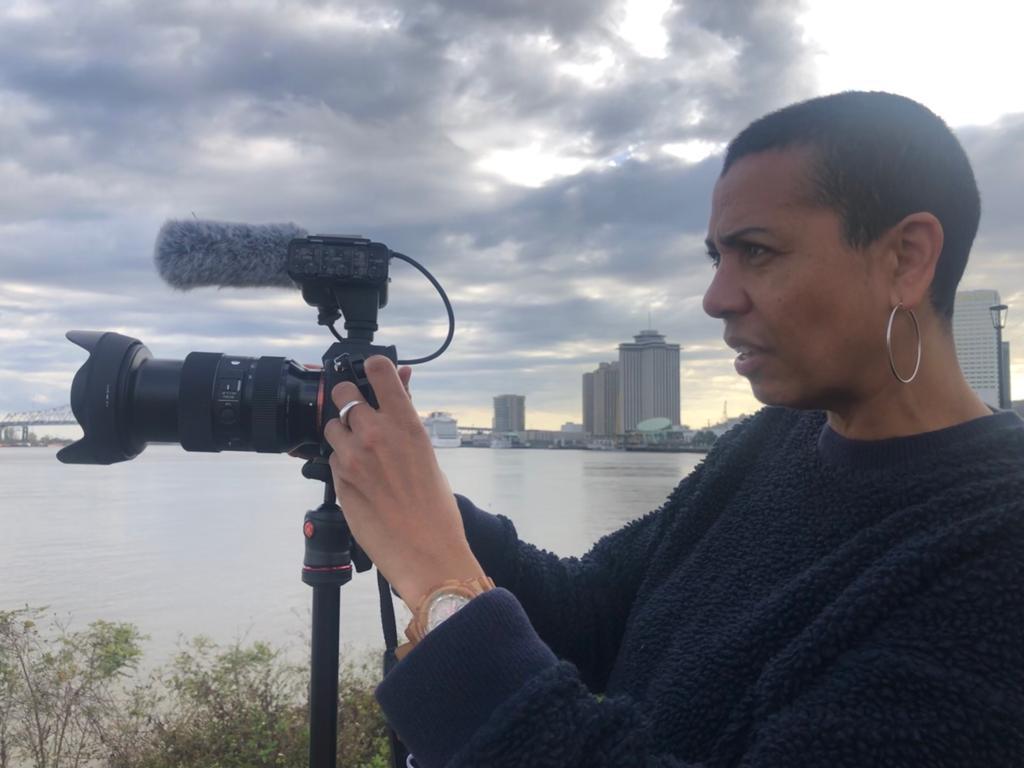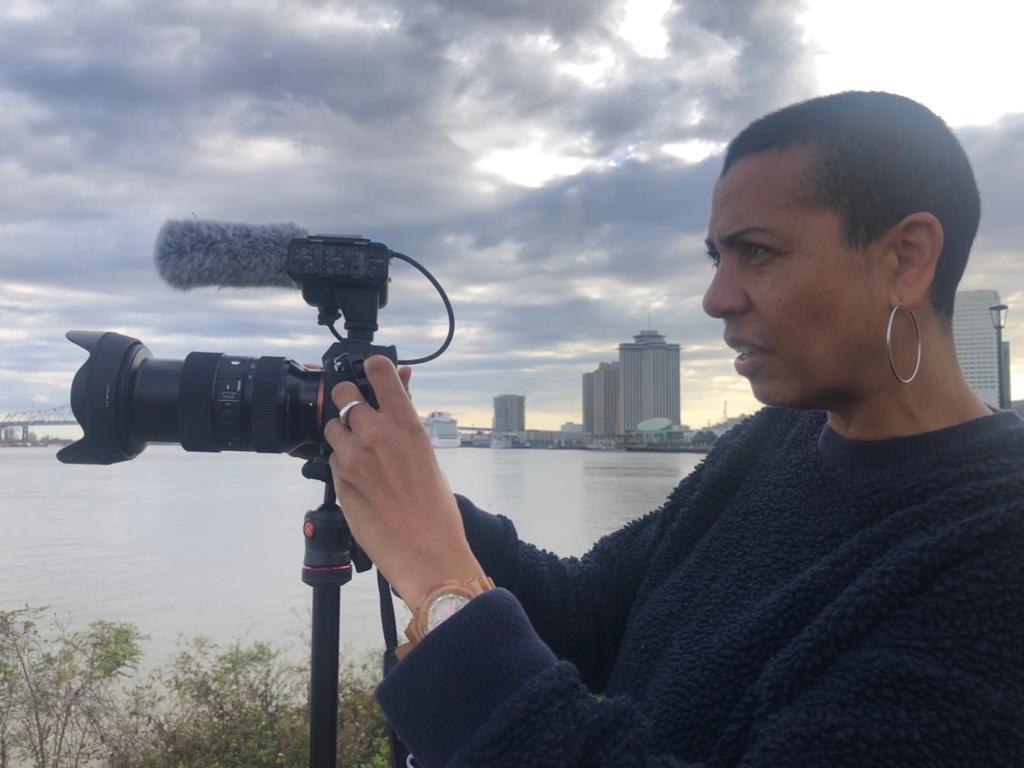This maxim reflects the bond between writer Tom Dent and his library at Amistad.
Amistad Welcomes Two Artists-in-Residence to the Archive


This past winter, the Amistad Research Center (ARC) welcomed British artist Helen Cammock to its archives for the Amistad-Rivers Research Residency—a collaborative venture between the Amistad Research Center and Rivers Institute for Contemporary Art & Thought. Supported by a Mellon Foundation grant, this residency represents an exciting partnership between the two organizations; artists are invited for extended research and study in the city of New Orleans and in Amistad’s archives. The purpose is to create tangible and intangible connections between internationally renowned contemporary artists and their work, ARC’s holdings and the wider cultural community of the city. In accepting the invitation to work in New Orleans, Cammock, the 2019 joint recipient of The Turner Prize, became the first artist-in-residence for this partnership.
In advance of her first stay in New Orleans, I diligently prepared in the archive – pulling materials from visual artist Elizabeth Catlett’s papers, oral histories from the civil rights interviews of the Kim Lacy Rogers Collection, and information about Mardi Gras Black Maskers in the Guardians of the Flame Collection. Cammock’s initial encounter with our manuscript and archival collections resulted in ongoing conversations and experiences with local cultural bearers, including Queen Cherice Harrison-Nelson of the Guardians of the Flame Maroon Society; Big Chief Demond Melancon of the Young Seminole Hunters; and the St. Augustine High School Marching 100 band.

During her two-part stay in January and April of this year, Cammock interviewed some of the ARC staff to glean their perceptions of the importance of the archive; she also spent extensive time engaging with the community as another form of historical excavation. Equipped with her camera and accompanied by her partner and producer Laura Shacham, Cammock explored New Orleans to film the magic of this place we call home. Cammock shared time with local rapper Five Star in areas surrounding Lake Pontchartrain and the historic Lincoln Beach in New Orleans East. She also spent time in the Seventh Ward to film conversations with St. Augustine’s band director Ray Johnson and with senior student arranger Raheim Mitchell. Big Chief Melancon invited Cammock to record moving images of him and his wife, Alicia, in his studio while beading and while he activated his masking suit in the streets of Treme. Lastly, ARC and Rivers hosted Cammock for an artist talk at the New Orleans Jazz Museum on April 20, where she shared insights of her practice and updated the audience on her new film, set for release in spring 2023.

Everyone at Amistad sends our deepest gratitude to Helen Cammock for sharing two months of exploration and vulnerability in and out of the archive with us. We also thank all of those who engaged with Cammock to create such a memorable experience.
Although we were sad to see Cammock depart, we were excited to open our doors for the arrival of the next artist-in-residence, Troy Montes-Michie. Due to the restrictions of the pandemic, Andrea Andersson (founding director and chief curator at Rivers Institute for Contemporary Art & Thought) and ARC reference staff initially guided Montes-Michie virtually through the ARC’s collections. This research worked in tandem with the opening of Montes-Michie’s recent exhibition, Troy Montes-Michie: Rock of Eye, a collaboration between Rivers and the host institution, California African American Museum. Montes-Michie’s early-career survey illuminates his research interests about the intersections between his experience as a queer man of Mexican and African American descent and ideas about migration, borderlands and belonging through textiles, fabric and paper. Montes-Michie experimentally works all of these threads into conversation through the zoot suit. This historical garment, popular among African-American, Mexican-American and other minority groups during the first few decades of the twentieth century, incited racial tension between communities of color and whites during World War II. The suit’s use of ample fabric for its roomy silhouette during a time when the country rationed food and textiles to support the war effort seemed unpatriotic to some and transformed the suit wearers into targets for violence, culminating in the 1943 Zoot Suit Riots in Los Angeles, CA.

Prior to physically arriving at ARC, Montes-Michie expressed very specific interests aligned with the themes presented in the Rock of Eye exhibition such as mentions of zoot suits, Black and Brown queer culture in Texas, and tailoring/suit construction. However, due to the current scope of the collection, pursuing these topics produced limited opportunities for tactile and graphic exploration. We pivoted to other collections, like that of Rex Madsen and Jimmie Daniels, as well as to that of Elizabeth Catlett, both with ample photographic works for an artist’s sharp eye. He quickly connected with the Richmond Barthé collection. Most people are immediately awed by the dynamic bronze sculptures of boxers, dancers and everyday working class people that emerge from the Black queer sculptor’s skillful hands. Although Montes-Michie experienced the same astonishment, he also felt an intuitive link to Barthé’s scrapbook, populated with intimate photos of family members, dear friends and travel companions. Many of our following visits included scouring through the remaining boxes of the Barthé papers, examining the late Dr. Margaret Rose Vendryes’ sweeping biography on Barthé, viewing the artist’s busts in the ARC’s fine art collection, and seeking out other traces of Barthé’s practice in the city of New Orleans. Thankfully, Dr. Stella Jones graciously welcomed us to view the Barthé sculptures at her Stella Jones Gallery. These amazing experiences resulted in Montes-Michie’s The Dreamer, a woven collage of found materials as well as scans of the photographs of Barthé’s sculptures in the ARC’s collection. Montes-Michie’s new work is being processed and will be available for viewing soon.

The Amistad Research Center looks forward to warmly welcoming Troy Montes-Michie back to continue his research in the fall.

The Andrew W. Mellon Foundation believes that the arts and humanities are where we express our complex humanity, and believes that everyone deserves the beauty, transcendence, and freedom to be found there. Through their grants, they seek to build just communities enriched by meaning and empowered by critical thinking, where ideas and imagination can thrive.
Images from Amistad’s website, newsletters and blogs cannot be reproduced without permission.
Explore More Articles
Hambrick is a Public Historian with a passion for collecting, preserving and interpreting history for diverse audiences. Her thirty-one-year career as a museum professional includes expertise in program development, interpretative planning, curation, grant writing, fundraising, and board governance. She led the effort to preserve three slave cemeteries and six historic buildings in Ascension Parish.
She is considered an expert on the history and culture of African Americans in communities along the Mississippi River. Kathe Hambrick’s interviews include local, national, and international media, the BBC Learning Channel, CBS Morning News, National Public Radio, and the New York Times. The consulting firm, 2PRESERVE was established by Hambrick in 2021 to provide cultural resources and guidance to corporations, museums, cultural centers, government agencies, and faith-based organizations.
Throughout her 31-year career, Kathe has curated over one hundred exhibits, including The Rural Roots of Jazz, African Influences on Louisiana Cuisine, Creole Du Monde, and The Square Collection which featured original art by Elizabeth Catlett, Jacob Lawrence, Richmond Barthé, and Tina Allen. Her most recent exhibit is the GU272 of Ascension: The Jesuit and Episcopal Connection to Slavery.
Kathe is the author and co-author of several books:
Hambrick is a Public Historian with a passion for collecting, preserving and interpreting history for diverse audiences. Her thirty-one-year career as a museum professional includes expertise in program development, interpretative planning, curation, grant writing, fundraising, and board governance. She led the effort to preserve three slave cemeteries and six historic buildings in Ascension Parish.
She is considered an expert on the history and culture of African Americans in communities along the Mississippi River. Kathe Hambrick’s interviews include local, national, and international media, the BBC Learning Channel, CBS Morning News, National Public Radio, and the New York Times. The consulting firm, 2PRESERVE was established by Hambrick in 2021 to provide cultural resources and guidance to corporations, museums, cultural centers, government agencies, and faith-based organizations.
Throughout her 31-year career, Kathe has curated over one hundred exhibits, including The Rural Roots of Jazz, African Influences on Louisiana Cuisine, Creole Du Monde, and The Square Collection which featured original art by Elizabeth Catlett, Jacob Lawrence, Richmond Barthé, and Tina Allen. Her most recent exhibit is the GU272 of Ascension: The Jesuit and Episcopal Connection to Slavery.
Kathe is the author and co-author of several books:
Hambrick is a Public Historian with a passion for collecting, preserving and interpreting history for diverse audiences. Her thirty-one-year career as a museum professional includes expertise in program development, interpretative planning, curation, grant writing, fundraising, and board governance. She led the effort to preserve three slave cemeteries and six historic buildings in Ascension Parish.
She is considered an expert on the history and culture of African Americans in communities along the Mississippi River. Kathe Hambrick’s interviews include local, national, and international media, the BBC Learning Channel, CBS Morning News, National Public Radio, and the New York Times. The consulting firm, 2PRESERVE was established by Hambrick in 2021 to provide cultural resources and guidance to corporations, museums, cultural centers, government agencies, and faith-based organizations.
Throughout her 31-year career, Kathe has curated over one hundred exhibits, including The Rural Roots of Jazz, African Influences on Louisiana Cuisine, Creole Du Monde, and The Square Collection which featured original art by Elizabeth Catlett, Jacob Lawrence, Richmond Barthé, and Tina Allen. Her most recent exhibit is the GU272 of Ascension: The Jesuit and Episcopal Connection to Slavery.
Kathe is the author and co-author of several books:




